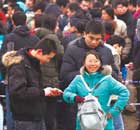Top Biz News
Opportunities and risks for Thais from economic cooperation
By Nophakhun Limsamarnphun (China Daily)
Updated: 2010-02-08 13:46
 |
Large Medium Small |
|
 |
|
A Thai shopper at a department store in Bangkok in December. [Getty Images] |
Opportunities and risks abound for Thai consumers and industries alike under the China-ASEAN Free Trade Area (CAFTA) agreement, which created the world's largest trading zone in terms of population when it came into effect in January.
Among various interest groups, Thai consumers are expected to be the main beneficiaries of the CAFTA, where the combined population is 1.9 billion. But Thai farmers and some domestic industries will face new challenges, due to the abolition of import tariffs protecting their goods.
Over the past 17 years, Thailand and other member countries of ASEAN - with a combined population of about 550 million - started to gradually reduce their import duties as part of the ASEAN Free Trade Area, better known as AFTA.
| ||||
In the first stage, only the six original members of ASEAN - Thailand, Malaysia, the Philippines, Indonesia, Singapore and Brunei - will enforce the zero-import-tariff mechanism. The remaining ASEAN members - Vietnam, Cambodia, Laos and Burma - will follow suit at a later stage.
For Thailand and the other original ASEAN members, a new era has begun. Consumers in all of them will benefit from lower prices of goods.
In principle, prices will be cheaper, due to the division of labor and specialization among producers within the new trading zone, while there will be greater product diversity.
Kiat Sitthi-amorn, president of the Thailand Trade Representative Office, said: "Thai consumers will definitely gain from the CAFTA, due to zero import tariffs. However, our domestic industries will face fiercer competition from imported products.
"Since 1993, industries such as electronics and electrical appliances, or garments and textiles, or automobiles, have taken lots of adaptive measures (to survive this new era).
"The auto sector appears to have done the best (in terms of competitiveness), but some other import-competing industries will still be hit."
In the end, the survivors will be those with the greatest efficiency in terms of raw materials, manpower, research and development and logistics. For Thai farmers, it is time to speed up improvements in productivity and crop varieties. A case in point is garlic. A few years ago, cheaper Chinese garlic flooded the Thai market, resulting in a reduction in the acreage planted to Thai garlic.
Indigenous garlic fetches a record price because there is less of it reaching the market, while the Chinese product has proved to be unpopular because of its texture and taste.
While Thailand's agricultural sector remains competitive, climate and domestic subsidies in each of the ASEAN markets and the huge Chinese market will be the other major factors affecting farm output and prices.
Despite implementation of the CAFTA, Thai farmers should generally fare even better this year than in 2009, because of lower agricultural output in neighboring countries, especially rice. The Philippines and India are already planning to buy more Thai rice.













